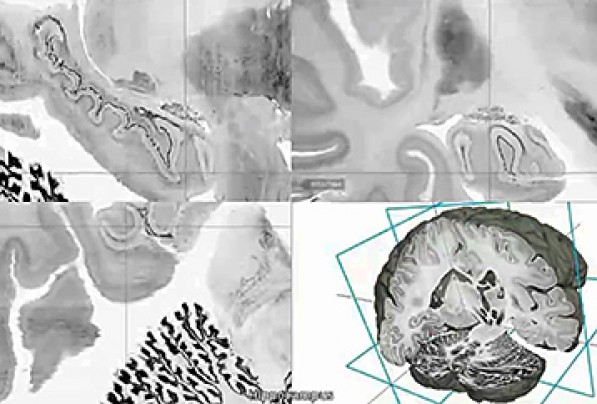当前位置: Language Tips> 双语新闻
Scientists create high-resolution 3-D atlas of human brain

|
The digital three-dimensional model called "BigBrain" was produced from the thousands of sections made from the brain of a 65-year-old woman. Its resolution is finer than a human hair, so it can reveal clusters of brain. A 65-year-old woman’s brain was cut into 7,400 slices to create the most detailed three-dimensional atlas of the human brain ever made, bringing researchers one step closer to reverse-engineering the brain’s convoluted circuitry. Brain atlases are essential reference tools for researchers and physicians, to determine which areas are “lighting up” during a task or thought process, or during image-guided surgery. The better the atlas resolution, the better doctors can target ever-smaller parts of the brain and their individual function. The atlas creators, who are from Canada and Germany, have made the ultrahigh-resolution model — 50 times more detailed than a typical scan — publicly available in a free online format. The authors also published their work in the journal Science on Thursday. The atlas, called BigBrain, offers a common basis for open, worldwide scientific discussion on the brain, said author Karl Zilles of the Heinrich Heine University Düsseldorf. Zilles pointed to a novel treatment for Parkinson’s disease called deep brain stimulation, where electrical impulses are sent through electrodes implanted into specific points in the brain. He said BigBrain may open the doors for more accurate localization of electrode placement and thus render treatment more effective. After staining and digitizing the thousands of plastic-wrap-like slices, the nearly cellular resolution map revealed the network of layers, fibers and microcircuits of the woman’s brain. While variation exists among brains, across ages and individuals, they have largely the same distribution of brain structures and anatomy, said author Alan Evans of McGill University’s Montreal Neurological Institute. There are “subtle shape changes among individuals,” but all atlases start from one representative brain and go from there. The team was chiefly limited by computing power and capacity. To map the human brain with 1 micron spatial resolution, which has been done for mouse brains, the atlas would take up 21,000 terabytes of data — essentially rendering it impossible to navigate. By comparison, BigBrain, with its 20 micron resolution, comprises about a terabyte of data. Prior MRI-based atlases had resolution of 1 millimeter. Richard Leigh, a Johns Hopkins neurologist, said he’s looking forward to test-driving BigBrain for his research on stroke recovery. With the microscopic detail available, Leigh can see which particular groups of neurons are growing through stroke treatment rather than just a general fuzzy area. Evans was in Seattle on Wednesday working with the Allen Institute for Brain Science. Created by Microsoft co-founder Paul Allen, who has committed $500 million since its start in 2003, the Allen Institute has assembled a less-detailed human brain atlas of its own. BigBrain is part of the European Union’s Human Brain Project that brings together specialists in neuroscience, medicine and computing to decipher the mysteries of the brain. President Obama announced in April an initiative to map the human brain, describing it as a way to discover cures for neurological disease and strengthen the economy. |
据《华盛顿邮报》6月21日报道,科学家成功绘制出有史以来分辨率最高的3D人脑图谱。这意味着,研究人员在大脑回路逆向工程方面的研究更进了一步。 大脑图谱是科研人员和医生必备的参考工具,通过图谱,他们可判定在工作、思维过程中,或是在图像导航的外科手术过程中,大脑哪个区域在变化。图像分辨率越高,医生就能更好地聚焦大脑微小的部位,研究它们各自的功能。 加拿大和德国的研究人员制作了这份大脑图谱,并于6月19日在《科学》杂志上发表。他们将一名已故的65岁女性的大脑切成7400片,将切片染色并进行数字化处理,最终生成高清模型,清晰地呈现出这名女性大脑的皮层、纤维和微电路结构。大脑图谱分辨率比普通扫描的精度高出50倍,并在网上对公众免费开放。德国杜塞尔多夫海因里希·海涅大学的卡尔·齐勒斯称,该图谱名叫“大脑”(BigBrain),它为在世界范围内公开对大脑进行科学讨论提供了基础。 齐勒斯指出,帕金森综合症有一种新治疗方法叫“深部脑刺激”,该方法通过植入大脑特定部位的电极输出电脉冲。他说,“BigBrain”能使电极植入的部位更精确,使治疗更有效。 麦吉尔大学蒙特利尔神经学研究所的艾伦·埃文斯称,由于年龄和个体不同,大脑也会有所不同,但人脑的结构有很大的共性。大脑“因个体不同会有微妙的形态变化”,但万变不离其宗。 这个研究团队受到计算机能力和容量的局限。研究人员曾绘制分辨率为1微米的老鼠大脑图谱,但如果要绘制同样精确的人脑图谱,将占用2.1亿亿字节的数据空间,基本不可能用来作图像导航。相比之下,“BigBrain”的分辨率是20微米,约占1万亿字节的空间。而此前磁共振成像(MRI)绘制的大脑图像精度是1毫米。 约翰·霍普金斯大学神经学家理查德·利表示,他期待将“BigBrain”用于他的中风康复研究。有了更清晰的大脑微观图像,利就可以观察到,在中风治疗期间,哪些特定的神经元簇有所生长,这比看起来模糊一片要好得多。 埃文斯6月19日在美国西雅图和艾伦脑科学研究所一起工作。2003年,微软公司的创始人之一保罗·艾伦出资5亿美元,联合建立了艾伦脑科学研究所。目前,该研究所已绘制了自己的人脑图谱,但是分辨率稍低。 BigBrain是欧盟“人脑工程”的一部分,该工程集中了一批神经学、医学和计算机领域的专家,欲破解大脑之谜。今年4月份,美国总统奥巴马曾宣布了一项大脑图谱工程,他认为,该计划可以找到治愈神经疾病的方法,还可以振兴美国经济。 相关阅读 (翻译:闻竹 编辑:Julie) |
上一篇 : 英国罕见“食羊植物”开花
下一篇 : 美国“机遇”号发现火星上存在生命起源之水
关注和订阅

电话:8610-84883645
传真:8610-84883500
Email: languagetips@chinadaily.com.cn